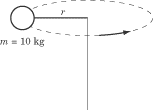Rotational motion deals with the rotation of a body or an object about its center of a mass. The movement of any object can be described through the combination of translational motion of the object’s center of mass and its rotational motion about that center of mass.
ANGULAR MOMENTUM
We can define angular momentum in terms of moment of inertia and angular velocity, just as we can linear momentum in terms of mass and velocity: L = Iw.
The angular momentum vector always points in the same direction as the angular velocity vector.
Angular Momentum of a Single Particle
Example: Tetherball of mass m swinging about on a rope of length r:
The tetherball has a moment of inertia of I = mr2 and an angular velocity of �� = v/r.
Substituting these values into the formula for linear momentum we get:The momentum, p = mv of a particle moving in a circle is always tangent to the circle and perpendicular to the radius. Therefore, when a particle is moving in a circle,
Sources: www.sparknotes.com/



Walang komento:
Mag-post ng isang Komento